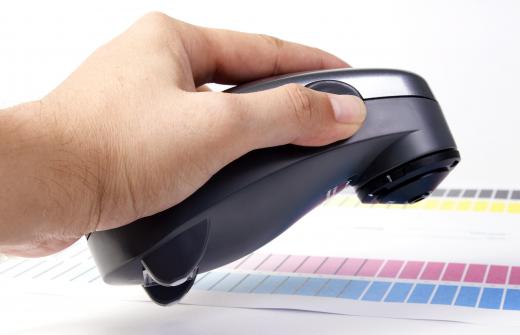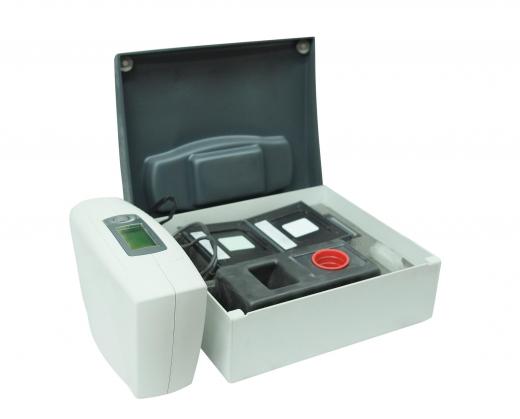What is Spectrophotometer Calibration?
 Mary McMahon
Mary McMahon
Spectrophotometer calibration is a process in which a scientific instrument known as a spectrophotometer is calibrated to confirm that it is working properly. This is important, as it ensures that the measurements obtained with the instrument are accurate. The procedure varies slightly for different instruments, with most manufacturers providing a detailed calibration guide in the owner's manual so that people know how to calibrate the equipment properly. When this process is performed, the person doing it must make a note in the log attached to the equipment and in their experimental notes, so that people know when the device was last calibrated and handled, and by whom.
A spectrophotometer is capable of both transmitting and receiving light. The device is used to analyze samples of test material by passing light through the sample and reading the intensity of the wavelengths. Different samples impact the light in different ways, allowing a researcher or technician to learn more about the materials in the test sample by seeing how the light behaves as it passes through the sample. Spectrophotometer calibration is necessary to confirm that the results are accurate.

In spectrophotometer calibration, a reference solution is used to zero out the equipment. This solution provides a base or zero reading. The device is calibrated by placing the reference solution inside the spectrophotometer, zeroing out the settings, and running the instrument. Then, samples of an actual test material can be subjected to spectrophotometry in confidence that the machine has been calibrated and is working properly.

In a single beam spectrophotometer, a single beam of light is generated, and the device must be recalibrated for each use. In a double beam spectrophotometer, beams can be sent through a test sample and a reference sample at the same time to generate two sets of results which can be used for reference and calibration. In either case, spectrophotometer calibration can be done in the lab by someone working with the machine. If the machine develops serious problems, it may be sent to the manufacturer for maintenance, repair, and potential replacement.
In order for a spectrophotometer to work properly, it must be allowed to warm up before use. Many devices take around 10 minutes to warm up. It is important to avoid performing spectrophotometer calibration during the warmup phase as this will throw the settings off. It is also important to be aware that for certain types of wavelengths, special filters and attachments may be needed for the device to function.
AS FEATURED ON:
AS FEATURED ON:












Discussion Comments
@glasshouse- Calibrating a UV spectrophotometer can vary from one instrument to the next, but there are a few important steps to consider when calibrating for a particular set of measurements.
First, the instrument needs to be connected to the proper interface and computer, and turned on to allow it to warm to operating temperature. If this step is ignored, your spectrophotometer will not give accurate measurements or save the measurements you take.
Next, place the cuvette with the blank solution, which cougars describes below, into the instrument and telling your instrument or computer to read this as your zero measurement for absorbance. To set your upper limit, look for a setting that will prevent the instrument from transmitting light. this will be how you set your infinite absorbance, which is the same as the zero percent transmittance.
Once you have your zero and infinite absorbance readings, the UV spectrophotometer is calibrated. At this point, it is ready for you to choose your wavelength (as cougars has explained). You should also check that your instrument is calibrated periodically since it can "fall" from calibration periodically. You can do this by returning your blank cuvette back to the instrument and checking to see if you have a zero reading. I like to be accurate and precise so I check calibration in between each series of measurements.
Can someone give me step-by-step directions on how to perform a spectrometer calibration? I have never used a spectrometer, and I missed the lab where we actually used one of these. I need to know how to calibrate one for my lab final, and I need to explain what the calibration and spectrometer does. I appreciate any response.
@anon108554- I do a lot of lab work, and I can tell you that a UV spectrophotometer should be calibrated before each use. The other reason for calibrating a spectrophotometer that I did not see mentioned in the article is that measurements are only correct if taken at a certain wavelength. Choosing the appropriate blank (the substance used to calibrate the spectrophotometer) will depend on the type of experiment you are conducting...what are you measuring the absorbance of?
In most cases, deionized water or another solvent is the best choice to calibrate your spectrophotometer. This will be the zero absorbance calculation (100% transmittance depending on what you are measuring). An undiluted substance you are experimenting with can then be used to determine maximum absorbance. Depending on the type of calorimeter or spectrophotometer you are using, you can cycle through the available wavelengths to find the wavelength that has the highest absorbance. This will then be the wavelength you should use for the experiment since it exhibits the highest absorbance.
which types of solution are prepared?
Post your comments